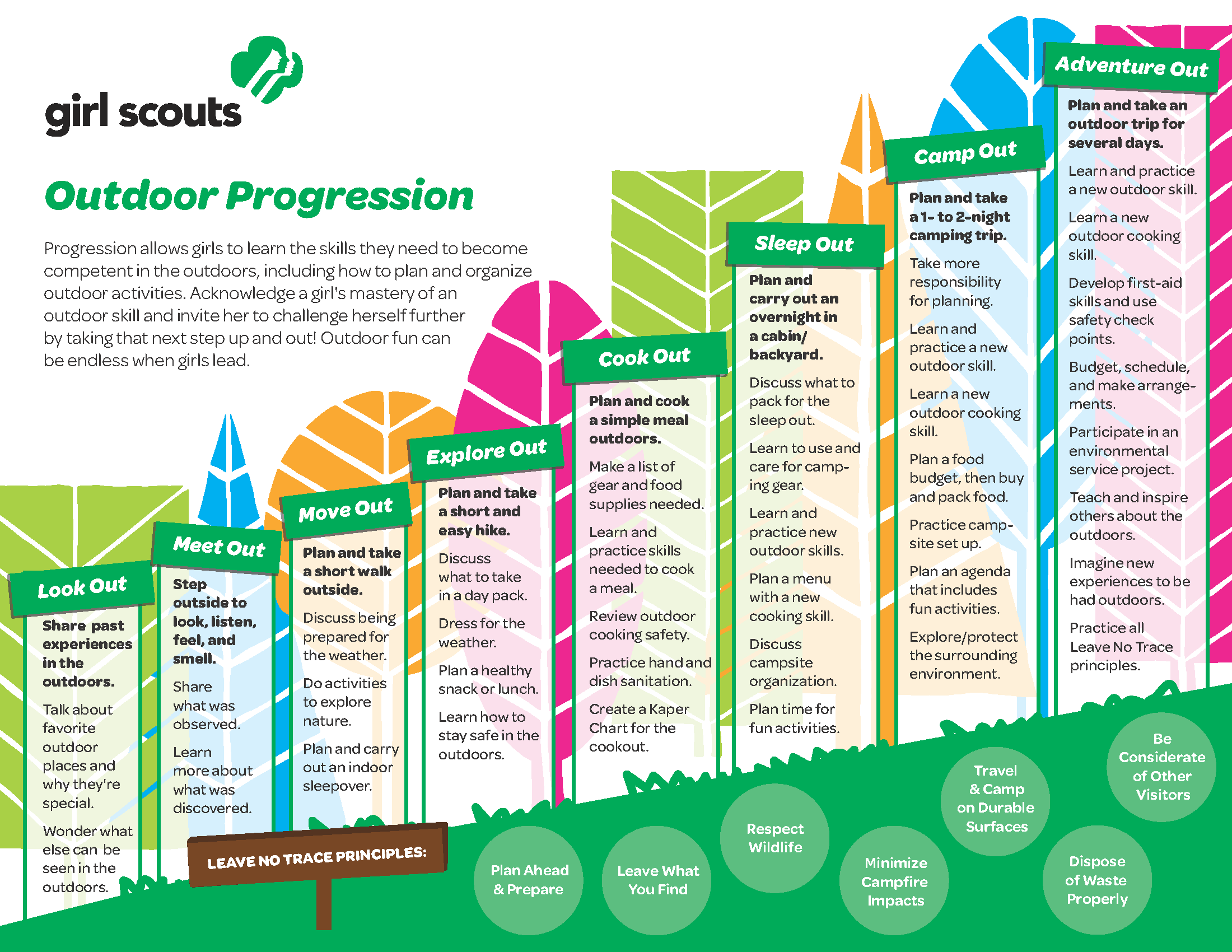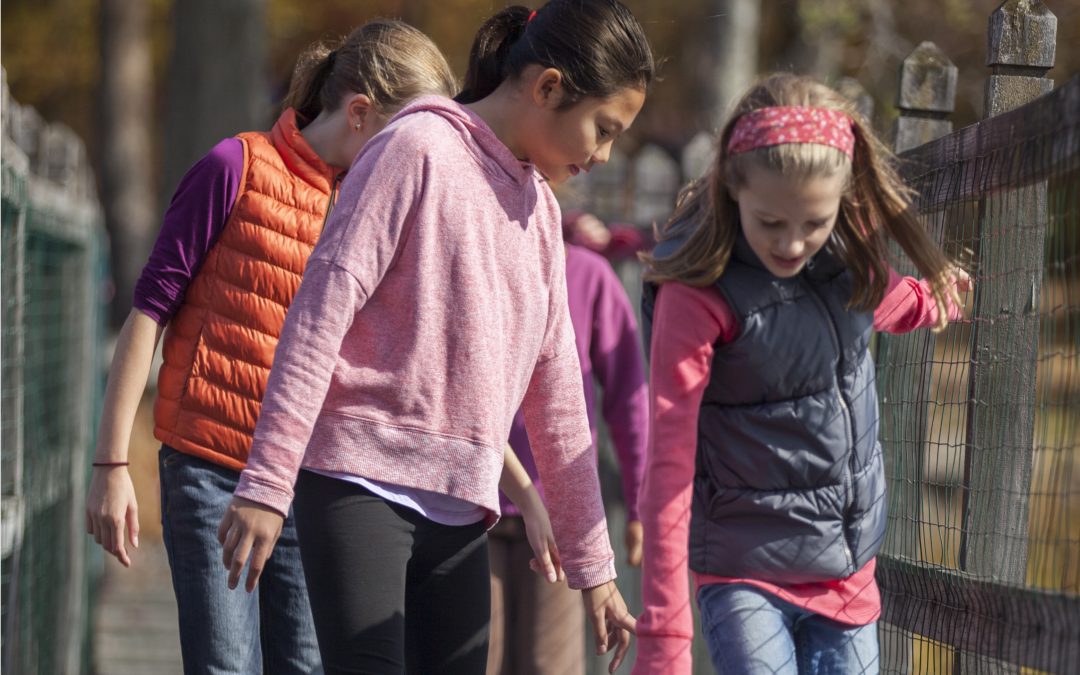Hello again! I’m back to share my 20+ years of camping experience to help you move through the steps of the Girl Scout Outdoor Progression Chart, because as you already know, I believe if a girl’s first outdoor experience is a positive one, she’ll be hooked for life. I hope everyone had a chance to get outdoors this summer—I know I had a summer full of outdoor time at all our Girl Scout summer camps. If you have girls in your troop who attended camp this summer, check in with them on what they did. They probably picked up some new outdoor skills that they would love to share with you and the rest of the troop.
In my last blog post, Move Out, I addressed the third step in outdoor progression where I covered how to plan a walk outside with your girls. If you haven’t already, don’t forget to review Steps 1, 2, and 3, Look Out, Meet Out, and Move Out. If you have, then let’s go ahead and get started on Step 4: Explore Out!

Just like the other steps we’ve covered, GSUSA lists a few examples on the Outdoor Progression Chart of ways you and your girls might take the Explore Out step together, like: planning a short and easy hike, discussing what to take on a day hike, dressing for the weather, planning a healthy snack or lunch, learning how to stay safe in the outdoors, and taking a day hike.
From packing your bag and planning your route to learning proper hiking etiquette and reflecting on your outdoor experience, here are 8 important topics to cover when planning a hike with your Girl Scouts:
Navigation
It’s a good idea to know where you and your girls will be going. Planning your route ahead of time and bringing map and compass resources in the event of poor or limited internet access is a great way to be prepared. Most trails and parks have free topographic maps available for download or order ahead some examples from the Pacific Crest Trail Association and the National Park Service. Printing out your map, highlighting your route, and getting an idea of the distance, elevations, and obstacles on your path ahead of time will help you estimate how long your day hike will take, decide what to wear and what to pack, and most importantly, plan for any avoidable geographical barriers or obstacles. While on your hike, you may encounter some helpful trail signs to guide you along your route. Make sure to familiarize the group on basic trail signs (or trail-specific signs if available) before heading out for your first hike.
Pro Tip: Planning for a day hike is the perfect time to start to explore how a map and compass work. REI, Appalachian Mountain Club, GSUSA, and the Orienteering Club have great articles on how to use a map and compass!
Sun Protection
I have talked about the importance of sun protection in past posts on The Trailhead, but it is always worth repeating. Nothing can ruin the memory of an awesome day hike like a sunburn. Remember to apply sunscreen to all exposed skin areas, bring extra sunscreen with you to reapply at the appropriate times, use SPF-rated lip balm, and wear sunglasses, a hat, and lightweight layers of clothing to cover up if you feel your sunscreen is failing. Even on cloudy days, the sun’s UV rays shine through, so remind your girls to protect their skin and use sunscreen before going outside.
What to Wear
When packing, avoid clingy cotton clothing and adjust each layer based on the forecast; always prepare for shifting temperatures, precipitation, and wind speeds. Basic day hike clothing might look like: a wicking long-sleeve top, comfortable hiking socks and shoes, quick-dry pants or shorts, a hat with a brim and neck protection, a fleece or soft-shell jacket, and a bandana. Always check the local weather for the start, end, and duration of your hike and pack rain and winter gear if snow, cold temperatures, or rain are in the forecast.
Illumination
You may be planning to return from your hike before dark, but your hike could take longer than planned or maybe the clouds and trees are blocking your sunlight. That’s why it’s always a good idea to pack at least 2-3 headlamps or flashlights as well as extra batteries. If you are planning to leave before dawn or return at dusk, you may want to increase that number to one per buddy team, or if returning at night, go with one flashlight or headlamp per person.
First-Aid Supplies
Be sure to inventory and restock your troop’s first-aid kit before your day hike. Have the volunteer first aider carry the first-aid kit in a backpack or if you have multiple kits, split the supplies among a few adults’ packs.
Not sure how a hiking first-aid kit might be different from your regular troop kits? Check out these hiking specific kits from the American Hiking Society and the Washington Trail Association to see what items might be missing from your troop’s first-aid kit. I recommend assembling a special first-aid backpack just for hiking and camping trips, making sure all the supplies are in weatherproof bags.
Nutrition and Hydration
In the next outdoor progression post, I will go over the Cook Out step. This is where we will learn about outdoor cooking and fire building. But for Explore Out, we’ll be focusing on hiking friend snacks, making sure everyone has enough food for the day (plus a little extra). Trail mix, dried fruits and veggies, and energy bars are some great travel-friendly snacks. For more recommendations, check out this blog post from Eat Right.
Don’t forget to keep your girls hydrated! Every hiker should have a water bottle or hydration reservoir. Check for water availability on the trail and bring extra water if there are no refilling options on your hike.
Pro Tip: If you’re looking to mix things up and sweeten up their hike, get together ahead of time and have your girls make their own sports drinks!
Hiking Etiquette and Rules
Whether in town or on the trail, your girls are Girl Scouts. Understanding and practicing basic hiking etiquette will help you represent the organization to the best of your ability, setting a great example for your Girl Scout hikers as well as any future Girl Scouts you may encounter during your expedition. Hiking etiquette is a natural partner to the Girl Scout Law with rules like: be friendly and courteous, only take pictures, leave what you find, if you carry it in then carry it out, stay on the trail, respect wildlife and never feed wild animals, respect private property, respect other visitors and their experience, avoid excessive noise, follow “Leave No Trace” principles, share the trail, keep to the right except to pass, warn people when you are planning to pass, and bicyclists yield to pedestrians and equestrians while runners and hikers yield to equestrians. In addition to these basic hiker tips, remember to check out local rules and regulations for the trail you and your girls will be hiking. Most parks and trails post their rule on their websites like the California Department of Parks and Recreation.
One rule to pay special attention to is “stay on the trail.” Staying on the trail serves two important purposes: (1) it prevents hikers from getting lost and (2) it maintains the natural areas around the trail. Taking unmarked “shortcuts” or bypassing muddy paths destroys vegetation, leads to erosion, reduces habitat quality, and causes unsightly damage to the landscape. And as Girl Scouts, we want to make the world a better place and leave no trace, rather than upsetting our natural surroundings.
Finally, don’t forget the debrief
Remember, Exploring Out is a significant step in the outdoor progression chart, so make sure to leave some time at the end of the day to give your girls the chance to share all the cool things they learned. Like any accomplishment in Girl Scouts, it’s worth talking about!
During your reflection time, build off your girls’ excitement and start planning your next hike. Ask them for trail suggestions or wildlife they want to see. Similarly to Move Out, don’t be afraid to ask questions about the route—ask if they thought the hike was too difficult or not challenging enough. And of course, don’t forget to jot down any recommendations that come up!
In my next blog post, I’ll talk about the next step in Girl Scouts Outdoor Progression Chart, Cook Out, which will introduce your girls to cooking outdoors. As always, thank you for taking the time to step outside of your comfort zone and encouraging your girls to explore the world around them. If you have any great ways to Explore Out or ideas for Cook Out, please share them in the comments section below! Until next time, Happy Trails!
What to do next:
- Looking for related reads? Check out our other blog posts about getting outdoors with your Girl Scouts!
- From setting up a campsite to outdoor songs, GSUSA’s Outdoor Resources page has tons of helpful tips and how-to videos.
- Have you been going through the Outdoor Progression Chart steps? Don’t forget to share your favorite outdoor activities and resources in the comments section below, and keep an eye out for my next blog post!
 Mary-Jane Strom—Mary-Jane is the Senior Director of Camps & Adventure at Girl Scouts of Northern California as well as a lifetime member of Girl Scouts, joining as a Brownie and completing her Gold Award in 1991. Mary-Jane fell in love with the outdoors and camping at a young age after her aunt sent her to Girl Scout camp as a birthday present. Mary-Jane has spent every birthday since at camp, returning summer after summer after summer. When not at camp, Mary-Jane enjoys a variety of other outdoor activities, like open water swimming and running.
Mary-Jane Strom—Mary-Jane is the Senior Director of Camps & Adventure at Girl Scouts of Northern California as well as a lifetime member of Girl Scouts, joining as a Brownie and completing her Gold Award in 1991. Mary-Jane fell in love with the outdoors and camping at a young age after her aunt sent her to Girl Scout camp as a birthday present. Mary-Jane has spent every birthday since at camp, returning summer after summer after summer. When not at camp, Mary-Jane enjoys a variety of other outdoor activities, like open water swimming and running.



I love this series!! I can’t seem to find the next step though –
Cook Out -? Would love to hear your ideas!